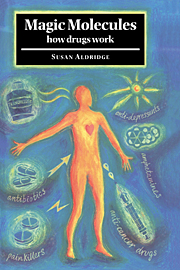Book contents
- Frontmatter
- Contents
- List of illustrations
- Acknowledgements
- Introduction
- 1 How drugs work
- 2 From penicillin to Prozac: introducing pharmaceutical drugs
- 3 Fighting infection
- 4 The hormonal revolution
- 5 Cardiovascular drugs: protecting the heart and brain
- 6 The problem of pain
- 7 The cancer challenge
- 8 Drugs for the mind
- 9 Drugs of recreation and addiction
- 10 Natural alternatives: vitamins, minerals and herbs
- 11 In the pipeline: gene-based medicine
- Bibliography
- Index
11 - In the pipeline: gene-based medicine
Published online by Cambridge University Press: 05 August 2012
- Frontmatter
- Contents
- List of illustrations
- Acknowledgements
- Introduction
- 1 How drugs work
- 2 From penicillin to Prozac: introducing pharmaceutical drugs
- 3 Fighting infection
- 4 The hormonal revolution
- 5 Cardiovascular drugs: protecting the heart and brain
- 6 The problem of pain
- 7 The cancer challenge
- 8 Drugs for the mind
- 9 Drugs of recreation and addiction
- 10 Natural alternatives: vitamins, minerals and herbs
- 11 In the pipeline: gene-based medicine
- Bibliography
- Index
Summary
The future of the pharmaceutical industry is certain to be shaped by genebased medicine (or genomics, as it is often called). Francis Crick and James Watson, co-discoverers of the structure of the DNA molecule in 1953, were insightful enough to see that their discovery would have a major impact on the understanding of how cells work. But it is doubtful if they then appreciated the practical potential of their discovery for human health (although Watson was, until recently, director of the Human Genome Project, whose implications for drug development we will discuss below).
DNA is the chemical which genes are made from, and it occurs within the nucleus of every cell in the body. It is a polymeric molecule, made of four types of repeating chemical units called nucleotides. These, in turn, are formed of three chemical parts – a phosphate group, a molecule of a sugar called ribose, and a base, which is a small molecule containing one or more nitrogen atoms. It is the base which varies; there are four types of base in DNA – adenine, guanine, cytosine and thymine (often abbreviated to A, G, C and T).
Crick and Watson showed that the DNA molecule consists of two separate strands wound around one another in a double helix. The phosphate groups are on the outside, while the bases face one another in pairs in the centre of the helix, joined together by weak chemical bonds known as hydrogen bonds (A always pairs with T and G with C). The ribose groups bridge the phosphates and the bases (see Fig. 11.1).
- Type
- Chapter
- Information
- Magic MoleculesHow Drugs Work, pp. 241 - 258Publisher: Cambridge University PressPrint publication year: 1998



